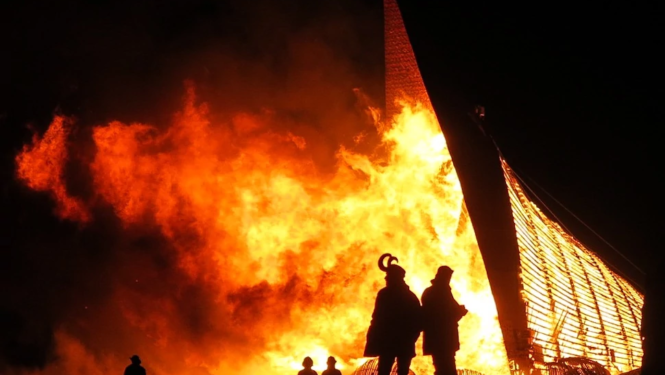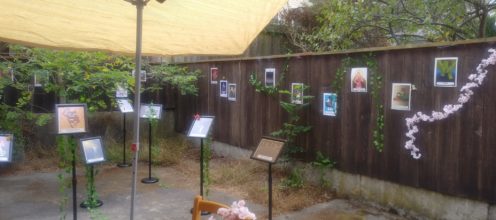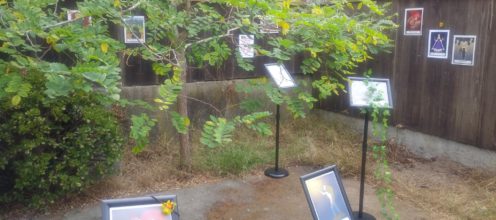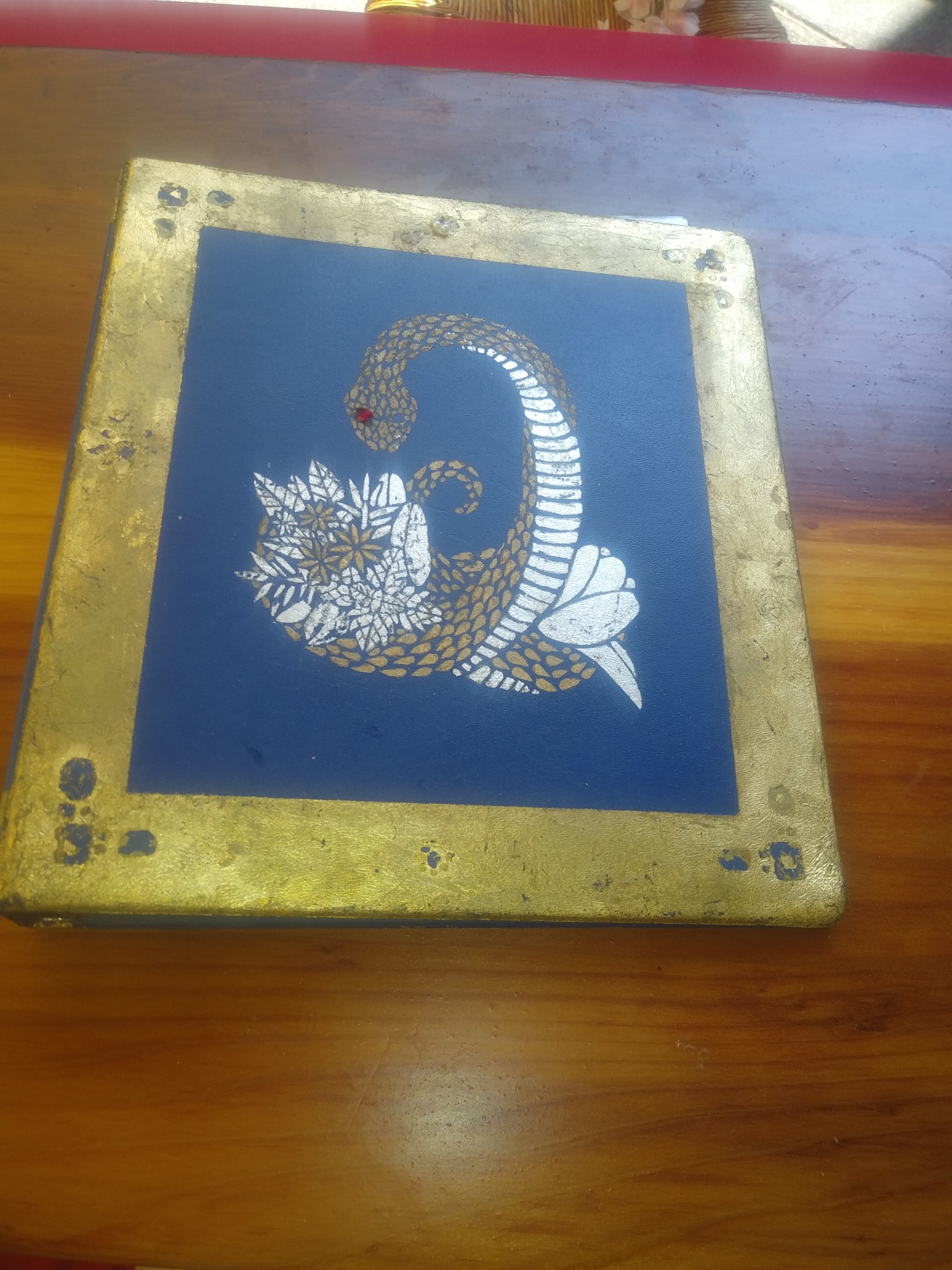The garage door rolls open with a rumble. You step from the bright outside into the long, shadowy, corridor. There’s a door on the other end. You walk to it, open it, and emerge into a small backyard, surrounded by other buildings. You blink in the light: there is a shade structure, some camping chairs, a table with some unrecognizable objects on it, and—just a little further out—dozens of pieces of art, some freestanding, some affixed to the walls, some emerging out of plants.
“Welcome to my theme camp,” I say. I offer you a drink from a cooler, and ask you to sit down. You stare at all the art—everyone stares at all the art—wondering what it is, but take the offered chair. I hadn’t invited you here just to look at art, after all: this is an art experience.
Why We Burn At Home
Last year, during a much more restrictive time of the pandemic, I decided that since there would be no Black Rock City I would instead turn my building’s small, mostly concrete, backyard into the site of an art experience, and invite everyone I could — close friends, acquaintances, and especially complete strangers — to come and participate in a (socially distanced, outdoor) act of Radical Self-expression.
Nearly 30 people visited that week. It was a deeply personal experience that felt more like Burning Man than I ever imagined. I was exalted. I melted down multiple times. It absolutely changed my life, and after 10 days of enacting a participatory ritual over and over again with everyone who came I was so profoundly glad I had done it and so deeply relieved it was over. It took me days to recover. I still have trouble talking about it.
This year, with Black Rock City not happening again, I considered going to Renegade Burning Man (although I’m not clear on the name: did anyone actually try to stop it?), but decided to create another backyard theme camp instead. Because while I love going out the playa and making magic, I believe even more deeply in the need for us to make art magic where we live.
Once again, I put out a notice — on social media and here on the Burning Man Journal — inviting anyone who would be in the area for the 10 days that I would normally be at Burning Man to come and have a new art experience at my theme camp. Complete strangers were especially welcome.
Last year I had done it all by myself. This year I worked with two partners: long-time theme camp organizer Hot Damn, and the artist Laurelle Stelle.
This is what we created.
Come As You Are — Leave As You Become
When the small talk is over, when we really begin, I tell you that we are going to start with an homage to the signs that we see on the road into Black Rock City every year: signs that have quotes on them about the theme, about the area of life we are considering this year. If you look on the table next to you, you’ll see there is an ornate and vaguely threatening binder. If you pick it up and look inside, you’ll find that there are quotes in it. They are on the theme that we are going to be exploring together. This is just to set the stage: there aren’t clues here, there’s no test, none of this will come up later. Read as many or as few as you want, and when you’re ready, we’ll continue.
Here’s a few of the things you’ll read:
“What you are living is but a fractional inkling of what is really within you — what gives you life, breadth, and depth.”
— Joseph Campbell
“On calm days, you always think you’ve conquered them.
You think that in the end you’ve finally done them in.
That you’ve got rid of them for good, now and forever.
But that seldom happens.
Most of the time, the demons are still there, lurking somewhere in the shadows.
Tirelessly waiting for the moment when our guard drops.
And when love goes away…”
― Guillaume Musso
“I have always thought of a myth as something that never was, but is always happening.”
― Jean Shinoda Bolen
“So clearly,” I say as you put the binder down, “we’ve been thinking a lot lately about personal mythology. About the way in which our psyches are mythological realms with their own histories and stories and entities, and the ways this connects to and is separate from the collective unconscious. And as part of this discussion, we informally started a practice of looking into our own heads and identifying our personal demons. Of finding those parts of ourselves that already seemed like they were personified, that had their own voices that talked to us and prodded us whether we wanted them to or not. And we investigated them. And this was interesting and insightful and useful, sure … but the really interesting thing, the really compelling moment, came when we began developing techniques to reach into our heads, grab our personal demons, and remove them from our psyches and put them into the physical world.
“It’s a cliché,” I say, “that those who don’t confront their demons on the inside will have to confront them on the outside. But that cliché assumes that you’re doing it unconsciously, by accident. But when you’re doing it on purpose? When you’re deliberately taking a demon out of your head and putting it into the real world? Then you have a whole lot of options that you don’t have when it’s still in your psyche. Then you can have a whole different relationship to it.
“That’s what we were doing when the question came up of what kind of art experience I wanted to create for my backyard Burning Man theme camp. And so,” I gesture around, “we created a Demon Garden. We took the demons out of our heads, and other people’s heads. We gave them physical form in the real world, and then put them through a ritual to plant them here, and now they’ve bloomed. Each piece here is someone’s personal demon. And I’d like to offer you, now, the chance to walk through this garden and take a look and have the experience of walking among the demons. To wander through it for as long as you like, with no specific path to take. Just look at whatever interests you, follow your inspiration. All the demons are labeled, so it should be clear what they are. However, if you want more information about a demon…”
I reach into a black box beside me and pull out a tablet and headphones.
“…we have an audio tour! Every demon in the garden is on this tablet, listed in alphabetical order, so if you see a demon you want more information about, just find it’s name, select it, and play the audio file. What you’ll hear is the person whose demon it is telling you about it. It’s all real: their voices, their demons, everything they have to say. Take as long as you like.”
If you take the tablet, if you go on the tour, you’ll travel through the demons, walking among them, getting up close to the ones that compel you, and listening to the people whose heads they came from tell you their stories. Many demons are about shame. Many are about perfectionism, and the urge to live up to society’s standards. A few of them are about wanting to disappear, to pretend you don’t have a body. Some of them are about anger and rage boiling up, some of them are about blame, some are about wasting time. Each one is different, each story is unique.
Maybe you only listen to the stories that compel you. Maybe you listen to all of them. Most people end up going through the entire garden, taking close to a half-hour wandering through, discovering more and more secrets.
“The garden started out with just 12 demons,” I tell you when you’re finished. “By the time this project is over, it will probably have over 50. That’s because each person who comes through the garden is offered the chance to plant one of their own demons here. To take it from their head, give it physical form, and then go through the ritual that plants it in the garden, so that it lives here now. Is that something you’d like to do?”
Almost everyone says yes.
If that’s something you want to do, you’re taken over to the camp table. “There are several ways to give demons physical form,” I say, “but since this is a Burning Man theme camp, we’re going to use art.” I open a box on the table to reveal a mass of art supplies. Paints, colored pencils, crayons, and more. I take out a large, square sheet of heavy stock paper, and put it down on the table, too.
“Now the point here isn’t to make good art,” I tell you. “This isn’t for display. No one else will see this image. This is to give your demon a physical form, to bring it into the physical world. So don’t worry about how it looks: the point is to be honest. That’s all that matters. Stick figures are fine. Some other things to think about as you do this process are: what role does this demon play in your life? How does it communicate with you? What does it tell you? What does it want you to say or do? What motivates it? Some demons think they’re being helpful, while some are just cruel. And, of course, what do you call it? Go ahead. Take your time. When you’re ready, we’ll do the ritual to plant it in the garden. And then in a few days time it will appear. I’m here if there’s anything you want to discuss, but take all the time you need.”
Almost no one wants to discuss anything during this process. Most people are absolutely absorbed in it. Many people, as they were going through the garden, were already thinking: “My demon isn’t here…”
Some of them come to the table with a clear idea of what they’re going to do. Some people have no idea what they’re going to create until, suddenly, it just starts appearing on the page. Some people are surprised by what they discover. Some people have known about a demon in their head for many years.
When you’re ready, I ask you to tell me about your demon. Then I ask if I can record you talking about it for our audio tour. Almost everyone agrees.
When you’re ready, we take it over to the ritual station: a fire bowl standing on a pedestal, at about chest height.
“We’re going to burn your demon,” I tell you, ”and then you’ll scatter the ashes in the garden, and that will plant it here, and it will blossom and appear, and be rooted here, in 2-3 days. But while you’re burning it, there’s something we want you to do. Because yes, the demon is out of your head now and in the physical world, and yes, we are going to be rooting it here in this garden. BUT … demons are sneaky. They’ll try to get back in your head. They’ll drunk dial you. They’ll text you. They’ll stalk you. So while your demon is burning, we suggest that you think of the truths that this demon needs to hear — the true things that you need to tell it, whatever they are, to make it clear that it can’t come back. That its time in your head is over. And then to say these truths out loud to your demon, as it turns to ash.”
I give you the lighter. I hold the demon over the fire bowl with tongs. You light it up. I don’t know what you have to say to your demon, I only know what other people have said. But you speak to the fire. These moments … they can be very powerful. There were many tears. There were many whispered moments of resilience and confession. I saw a man tell his burning demon, for the first time in his life, “I’m not that little boy anymore,” as his tormentor went up in flames.
When it’s finished, you scatter the ashes in the garden. We give you a card on which to write the things you told your demon, and you take this card with you so that you’ll always have these words on hand.
And then you’re welcome to stay for as long as you like, though there’s also probably someone coming in a half-hour or less to walk through the long shadowy corridor into the garden, and experience this for themselves.
In a few days, I’ll send you a picture of your demon here in the garden, nestled among the plants. In a few days, when people come here, they’ll see your demon too, and hear your voice.
How Does Your Garden Grow?
Doing this experience over the course of 10 days, watching the garden grow, seeing their demons and hearing their stories, and burning these parts of themselves, was exhausting. Utterly draining. Everyone involved in making the project had meltdowns.
It was also wonderful, sublime, and utterly magical. To me, it felt very much like Burning Man.
It can happen anywhere. Anyone can do it.
Cover image of Demon at the Temple Burn, 2015 (Photo by Becci Brace)
All other photos courtesy of the author






Reminder: Burning Man Project has a responsibility to maintain this space for the benefit of all participants, to ensure that comments serve to enhance the experience of our visitors, rather than cause harm. While spirited conversation is welcome, unruly and rude behavior is not. Posts that are harmful to others or run counter to the spirit of civil discourse may be removed.
Please review our COMMENT POLICY here, then comment with care: https://journal.burningman.org/comment-policy/
Report comment
Caveat, Thanks so much for opening your home to strangers, creating this experience, and all you do. It was all you described, and welcome respite from this year without Black Rock City.
Report comment
The moments of Burning Man, or anything really, that stick and resonate, are those special experiences that break through the day-to-day interactions we almost sleep-walk through. The Demon Garden was one of those that stood out. People reached inside and creatively shared aspects of themselves and it made me not only think about it, but have the courage to do the same. I was fortunate and glad to partake. Thank you, Caveat
Report comment
I visited on the last day. It was a beautiful and meaningful experience. Grateful to Caveat for bringing it into the world.
Report comment
I wish I could visit that magical garden but unfortunately I live in Italy. Hopefully see all of you at BRC
Report comment
Caveat, you remain a wonder, a gracious soul, and a treasure beyond words. Thank you, Chanel
Report comment
I love this so much, I could cry.
It took me 15 years hearing about how intensely, wildly, unforgivably wondrous Black Rock City was to get my ass out there. And once I did? I discovered a part of me I didn’t know existed – my heart and my mind sponged up every drop of creativity and humanity it could.
Thank you, Caveat. Your words and perspectives always serve as a sweet reminder that Burning Man exists for a reason.
(Thanks Larry)
Report comment
I love this so much!!! Wish I were closer and could have attended.
Report comment
Comments are closed.